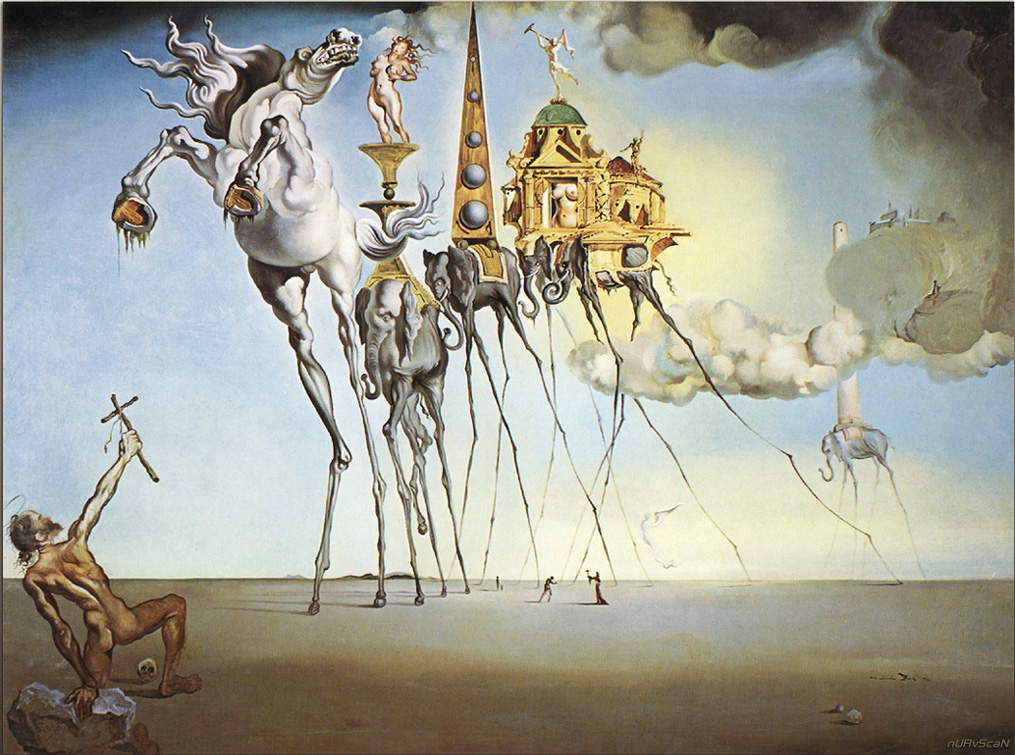
Picture a gaggle of gangly elephants gyrating about on a desert landscape as a lone man, naked and unprotected, attempts to resist the gilded promises they offer him.
This is not a metaphor for how the Republican Party’s 2016 presidential victory — which at first appeared to free the American people from their Bush and Obama-era bureaucratic enslavement — will actually only bind the nation further into the thralls of technocratic liberalism, primarily because of our new president’s obsession with deals, costs, and efficiency. This is just Salvador Dalí’s 1946 painting “The Temptations of Saint Anthony.”
Dalí, the Spanish surrealist best remembered for “The Persistence of Memory” — a 1931 painting of melting clocks drooping on a desertscape — died 28 years ago on Monday, but his life and works remain an artistic backdrop for the absurdity of the modern project.
Always the eccentric, during his life Dalí tried to distance himself from society in which he lived — mustachioed and old, in 1969 he once hobbled up the stairs of the Paris metro so he could give his pet anteater a breath of fresh air. Another time, at the opening of the London Surrealist exhibition in 1936, he dressed in a wetsuit with a billiards cue stick in hand and gave a lecture on “plunging into the depths of the human mind” while walking a pair of Russian wolfhounds. Actress Mia Farrow, who starred in Roman Polanski’s 1968 horror film “Rosemary’s Baby” about the birth of the anti-Christ, recalled that later in life Dalí would send her a telegram every year on Palm Sunday that read “Palm Sunday. Palm Sunday. Palm Sunday.”
But Dalí was not the avant-garde clown he often made himself out to be. The artist had a keen fascination with how modern science and how the invention of the atomic bomb affected the way men live in society. Dalí considered modern atomic theory — and all the intellectual efforts of the 20th century — a three-part attempt to understand humanity in strictly material terms.
“The specialized sciences of our time are concentrating on the study of the three constants of life: the sexual instinct, the sentiment of death, and the anguish of space-time,” he said in a 1968 interview.
Dalí’s belief about the human condition pervades the bulk of his works. Early paintings depict the dictators Hitler and Lenin distorted in a Freudian sexual imagery. Middle works, such as “The Persistence of Memory,” depict a fascination with time trapped in the material world. Later in life, Dalí embraced Catholicism, and his work reflects a despair at modern science’s attempt to define man’s meaning in purely material terms. “Corpus Hypercubus” (1954) presents Christ crucified on a tesseract and “The Temptations of Saint Anthony” (1946) depict the hermit repelling a host of elephant-borne lusts with a cross.
This final image — St. Anthony warding off sensual desire incarnate in the long-legged elephant — remains one of Dalí’s most well-known images. For in it, the artist uses all of his absurdities, his optical tricks, to present a man desiring holiness yet assaulted by a world that wants him to focus only on selfish and material desire. It’s an image that everyone, whether they stand on the left or the right, should be viewing right now.
In the now over-a-century long struggle between Marxism and capitalism in the American political scene, we have forgotten that neither ideology gives us meaning. The Reagan-era conservatives can shout controlling a people’s destinies with a technocratic government won’t give us fulfillment, and they would be right. But then — come on — neither will the free market.
The rough beast that came slouching toward Washington this past week was just Dalí’s old elephant. It never mattered if the Republicans or the Democrats won in 2016 — that spider-like elephant would come marching in just the same, bearing Dalí’s vision of the modern project — a society obsessed with sexual identity, racing against the melting clock to make America great again.
Raise your crucifix high and resist the temptation to join in.

